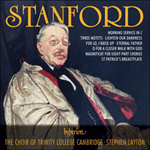The Fantasia and Toccata in D minor, Op 57, was completed in July 1894, though not published until 1902 by Houghton, and, later, by Stainer & Bell. It was dedicated to his colleague at the RCM, Sir Walter Parratt, who was Professor of Organ there as well as Director of Music at St George’s Chapel, Windsor. Parratt (along with his older contemporary, Stainer) was one of the first genuine virtuoso organists in England at the end of the nineteenth century, and his importance to the development of the organ profession can be witnessed in his organ recitals which abjured the more traditional programming of arrangements of the ‘classics’ in favour of original works for the organ. The fantasia, with its strong opening flourish, mimics Bach’s fantasia and fugue in G minor, BWV542, though Stanford’s gesticulative dissonances at the conclusion to each phrase are thoroughly romantic as is the panoply of chromatic progressions. Bachian too is the secondary allegretto con moto section in compound time. A repeat of the first animated paragraph in F major is concluded by a reprise of the allegretto, now transformed in D major, and a coda in which the initial flourishes are presented in dialogue between the hands. The toccata invokes the mood and figuration of the ‘Dorian’ toccata and fugue, BWV538. A ‘free’ form, like its fantasia counterpart, it has an aura of improvisation, but, as one would expect, this apparent ‘looseness’ conceals a sophisticated concerto design in which the opening figure for pedals constitutes a functioning ritornello, punctuating the important formal modulations to related keys, while the toccata material for the hands constitutes the ever-expanding, tonally fluid episodes. An exciting, dynamically rhythmical work, it concludes, like many toccatas, with an extended tonic pedal and a majestic Buxtehude-like gesture for full organ.
from notes by Jeremy Dibble © 2017
Le Fantaisie et Toccata pour orgue (1894) montre clairement comment Stanford fut influencé et inspiré par la musique allemande, surtout celle de Brahms et de Mendelssohn. Après la conclusion lyrique de la Fantaisie dramatique, le pédalier annonce le thème de la Toccata; commence alors une palpitante chevauchée, qui voit la tension musicale grimper sans cesse vers la magnifique conclusion.
extrait des notes rédigées par James O'Donnell © 2005
Français: Hyperion Records Ltd
Die Fantasia und Toccata für Orgel entstand 1894 und zeigt deutlich, inwiefern Stanford von der deutschen Musik, besonders von den Werken Mendelssohns und Brahms’, beeinflusst und inspiriert war. Nach dem lyrischen Ende der dramatischen Fantasia kündigt die Pedalstimme das Thema der Toccata an, womit eine aufregende Achterbahnfahrt beginnt, bei der sich die musikalische Spannung kontinuierlich bis zu dem großartigen Ende aufbaut.
aus dem Begleittext von James O'Donnell © 2005
Deutsch: Viola Scheffel


 Stanford: Choral Music
Stanford: Choral Music
